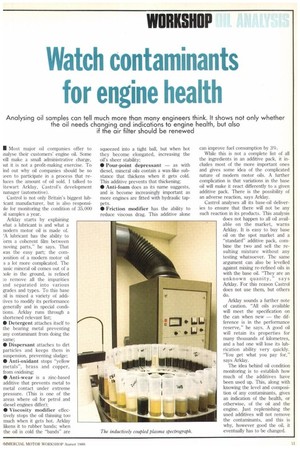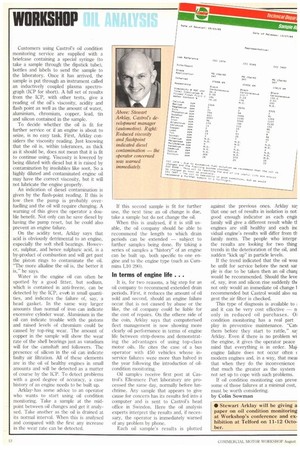Watch contaminants for engine health
Page 107

Page 108

If you've noticed an error in this article please click here to report it so we can fix it.
Analysing oil samples can tell much more than many engineers think. It shows not only whether the oil needs changing and indications to engine health, but also if the air filter should be renewed
• Most major oil companies offer to Inalyse their customers' engine oil. Some viii make a small administrative charge, iut it is not a profit-making exercise. To ind out why oil companies should be so teen to participate in a process that reluces the amount of oil sold. I talked to itewart Arklay, Castrol's development nanager (automotive).
Castrol is not only Britain's biggest lubicant manufacturer, but is also responsiile for monitoring the condition of 35,000 samples a year.
Arklay starts by explaining vhat a lubricant is and what a nodenn motor oil is made of. 'A lubricant has the ability to 'orrn a coherent film between moving parts," he says. That as the easy part; the cornxisition of a modern motor oil s a lot more complicated. The )asic mineral oil comes out of a iole in the ground, is refined to remove all the impurities and separated into various grades and types. To this base oil is mixed a variety of additives to modify its performance generally and in special conditions. Arklay runs through a shortened relevant list;
• Detergent attaches itself to the bearing metal preventing any contaminant from doing the same; • Dispersant attaches to dirt particles and keeps them in suspension, preventing sludge; • Anti-oxidant stops "yellow metals", brass and copper, from oxidising; • Anti-wear is a zinc-based additive that prevents metal to metal contact under extreme pressure. (This is one of the areas where oil for petrol and diesel engines differ); • Viscosity modifier effectively stops the oil thinning too much when it gets hot. Arklay likens it to rubber bands; when the oil is cold the "bands" are
squeezed into a tight ball, but when hot they become elongated, increasing the oil's sheer stability;
• Pour-point depressant — as with diesel, mineral oils contain a wax-like substance that thickens when it gets cold. This additive prevents that thickening; • Anti-foam does as its name suggests, and is become increasingly important as more engines are fitted with hydraulic tappets.
• Friction modifier has the ability to reduce viscous drag. This additive alone
can improve fuel consumption by 3%.
While this is not a complete list of all the ingredients in an additive pack, it includes most of the more important ones and gives some idea of the complicated nature of modem motor oils. A further complication is that variations in the base oil will make it react differently to a given additive pack. There is the possibility of an adverse reaction, says Arklay.
Castro' analyses all its base-oil deliveries to ensure that there will not be any such reaction in its products. This analysis does not happen to all oil available on the market, warns Arklay. It is easy to buy base oil on the spot market and a "standard" additive pack, combine the two and sell the resulting mixture without any testing whatsoever. The same argument can also be levelled against mixing re-refined oils in with the base oil. "They are an unknown quanity," says Arklay. For this reason Castrol does not use them, but others do.
Arlday sounds a further note of caution. "All oils available will meet the specification on the can when new — the difference is in the performance reserve," he says. A good oil will retain its properties for many thousands of kilometres, and a bad one will lose its lubrication ability very quickly. "You get what you pay for," says Arklay.
The idea behind oil condition monitoring is to establish how much of the additives have been used up. This, along with knowing the level and composition of any contaminants, gives an indication of the health, or otherwise, of the oil and the engine. Just replenishing the used additives will not remove the contaminants, and this is why, however good the oil, it eventually has to be changed. Customers using Castrol's oil condition monitoring service are supplied with a briefcase containing a special syringe (to take a sample through the dipstick tube), bottles and labels to send the sample to the laboratory. Once it has arrived, the sample is put through an instrument called an inductively coupled plasma spectrograph (ICP for short). A full set of results from the ICP, with other tests, give a reading of the oil's viscosity, acidity and flash point as well as the amount of water, aluminium, chromium, copper, lead, tin and silicon contained in the sample.
To decide whether the oil is tit for further service or if an engine is about to seize, is no easy task. First. Arklay con siders the viscosity reading. Just knowing that the oil is, within tolerances, as thick as it should be, does not mean that it is fit to continue using. Viscosity is lowered by being diluted with diesel but it is raised by contamination by insolubles like soot. So a highly diluted and contaminated engine oil may have the correct viscosity, but it will not lubricate the engine properly.
An indication of diesel contamination is given by the flash-point reading. If this is low then the pump is probably over fuelling and the oil will require changing. A warning of this gives the operator a dou ble benefit. Not only can he save diesel by having the pump reset, but he could also prevent an engine failure.
On the acidity test, Arklay says that acid is obviously detrimental to an engine, especially the soft shell bearings. Howev er, sulphur, and hence sulphuric acid, is a by-product of combustion and will get past the piston rings to contaminate the oil. "The more alkaline the oil is, the better it is," he says.
Water in the engine oil can often be spotted by a good fitter, but sodium, which is contained in anti-freeze, can be detected by the ICP, eveh in small quantities, and indicates the failure of, say, a head gasket. In the same way larger amounts than normal of iron can indicate excessive cylinder wear. Aluminium in the oil can indicate trouble with the pistons and raised levels of chromium could be caused by top-ring wear. The amount of copper in the sample will show the wear rate of the shell bearings just as vanadium will for the camshaft and followers. The presence of silicon in the oil can indicate faulty air filtration. All of these elements are in the oil of healthy engines in small amounts and will be detected as a matter of course by the ICP. To detect problems with a good degree of accuracy. a case history of an engine needs to be built up.
Arklay has some advice to an operator who wants to start using oil condition monitoring. Take a sample at the mid point between oil changes and get it analysed. Take another as the oil is drained at its normal interval. When this is analysed and compared with the first any increase in the wear rate can be detected. If this second sample is fit for further use, the next time an oil change is due, take a sample but do not change the oil.
When this is analysed, if it is still usable, the oil company should be able to recommend the length to which drain periods can be extended — subject to further samples being done. By taking a series of samples a "history" of an engine can be built up, both specific to one engine and to the engine type (such as Cummins 1.10 290).
In terms of engine life. . .
It is, for two reasons, a big step for an oil company to recommend extended drain periods. First, it reduces the amount of oil sold and second, should an engine failure occur that is not caused by abuse or the like, the oil company could be liable for the cost of repairs. On the othere side of the coin, 4rklay says that computerised fleet management is now showing more clearly oil performance in terms of engine life between strip-downs and demonstrating the advantages of using top-class motor oils. He cites the case of a bus operator with 450 vehicles whose inservice failures were more than halved in the year following the introduction of oilcondition monitoring.
Oil samples receive first post at Castrol's Ellesmere Port laboratory are processed the same day, normally before lunchtime. Any sample that appears to give cause for concern has its results fed into a computer and is sent to Castrol's head office in Swindon. Here the oil analysis experts interpret the results and, if necessary, the operator is immediately warned of any problem by phone.
Each oil sample's results is plotted against the previous ones. Arklay sa! that one set of results in isolation is not good enough indicator as each engit family will give a different result while ti engines are still healthy and each in( vidual engine's results will differ from th family norm. The people who interpr the results are looking for two thing trends in the deterioration of the oil, and sudden "kick up" in particle levels.
If the trend indicated that the oil wou be unfit for service before the next sar pie is due to be taken then an oil chanj would be recommended. Should the leve of, say, iron and silicon rise suddenly thi not only would an immediate oil change I recommended but Castrol would also su gest the air filter is checked.
This type of diagnosis is available to ; and it can be very cost effective — n only in reduced oil purchases. Oi condition Monitoring has a real part play in preventive maintenance. "Cati them before they start to rattle," sa: Arklay. Even if there is no problem wi the engine, it gives the operator peace mind that everything is in order. Ma} engine failure does not occur often modern engines and, in a way, that meal that when they do the inconvenience that much the greater as the system not set up to cope with such problems.
If oil condition monitoring can preve some of those failures at a minimal cost, must be worth considering.
by Colin Sowman




































































































































